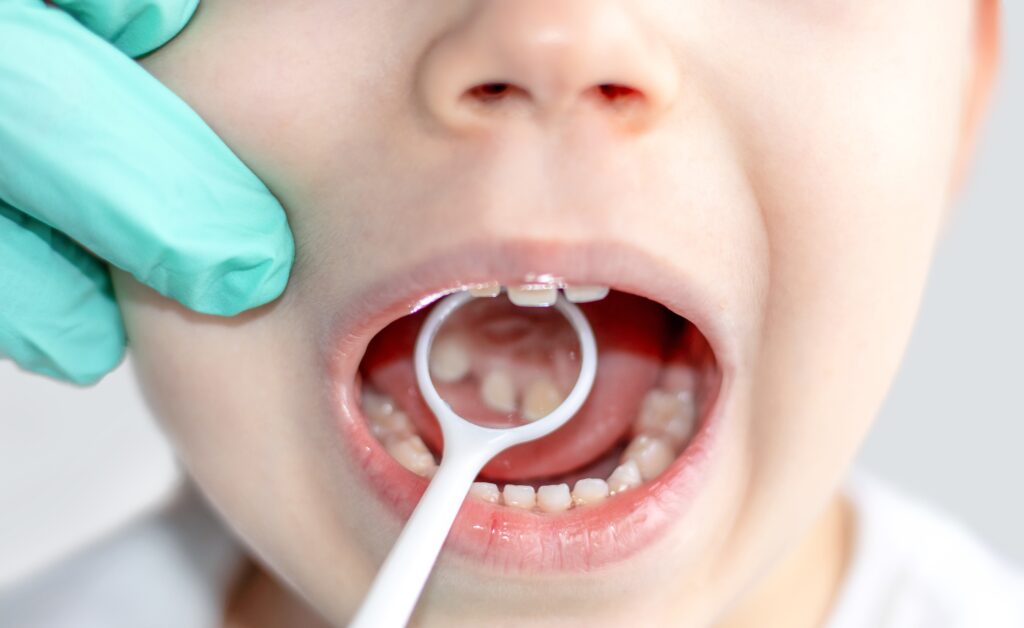Tiny teeth are working hard behind the scenes, helping kids eat, speak, and grow into confident grins. But even small smiles aren’t safe from big dental issues like cavities. Understanding how cavities form (and how quickly they can move from harmless to harmful) is one of the best ways to protect your child’s oral health. In this guide from Weideman Pediatric Dentistry & Orthodontics, we’re breaking down what really happens when tooth decay sets in by looking at the stages of a cavity, so you know when to act and how to stay ahead.
What Is A Cavity?
Cavities may be small, but they’re not shy about causing trouble. They form when bacteria in the mouth feed on sugars from food and drinks, then release acid that slowly wears down the enamel, the tooth’s outer shell. Over time, this creates a weak spot that can turn into a hole.
Kids are especially prone to cavities because their brushing habits are still developing, their diets often include more cavity-causing snacks, and their enamel is thinner than an adult’s. But that doesn’t mean cavities are inevitable—or harmless. Left untreated, even a tiny spot can grow into something painful, damaging, and harder to treat.
Baby teeth aren’t immune either. Even though they eventually fall out, they play an important role in speech, chewing, and guiding permanent teeth into place. That’s why early care matters. The sooner cavities are spotted, the easier they are to treat—and the better the outcome for your child’s growing smile.
Let’s take a look at the cavity stages and what happens in each.
Stage 1: Demineralization Begins
Tooth enamel is the hardest substance in the body, but it’s not invincible. Plaque, a sticky mix of bacteria and food particles, loves to cling to it, especially in hard-to-reach places like the grooves of molars and between teeth. When those bacteria feed on sugar, they produce acid, which wears away the enamel over time.
At first, this damage might show up as a chalky white or light brown spot. Your child won’t feel pain, and you might not even see anything unless you’re looking closely or visiting the dentist regularly.
This is the best time to step in. With a little help—like fluoride, sealants, or simply brushing more thoroughly—this early damage can often be reversed before a full-blown cavity even forms.
Stage 2: Enamel Decay
If early a damaged tooth enamel is missed or ignored, the decay progresses. The once-subtle spot becomes a more obvious pit or groove in the enamel, and bacteria have an easier path inward.
Your child still might not complain of pain. But the decay is no longer reversible. At this stage, a small filling is typically needed to stop the cavity from reaching deeper layers of the tooth. It’s a relatively simple fix, but still more invasive than fluoride alone.
Think of it like patching a tiny crack before it spreads across the whole windshield.
Stage 3: Decay Reaches The Dentin
Dentin is the softer layer beneath enamel. Once decay reaches this point, things speed up. Dentin contains microscopic tubules that lead straight to the nerve of the tooth, so even mild damage can start to cause symptoms.
Many kids report sensitivity to sweets, hot or cold foods, or pain while brushing. You might notice them avoiding certain foods, chewing on one side, or expressing discomfort that comes and goes.
Treatment now requires a larger filling from our team in Citrus Heights, and there’s a higher risk of nerve involvement if it’s delayed. The earlier you catch this stage, the easier it is to treat without more advanced procedures.
Stage 4: The Pulp Is At Risk
Inside every tooth is a bundle of blood vessels and nerves called the pulp. If decay reaches this inner core, it becomes an emergency. The pulp gets inflamed, and infection sets in. This is the stage most associated with toothaches that keep kids up at night.
Your child might complain of:
- Throbbing pain
- Swelling in the gums
- Sensitivity to pressure or chewing
At this point, a regular filling won’t cut it. The tooth may need a pulpotomy (a pediatric version of a root canal) or even a crown. It’s still treatable, but it’s far more complex and can be emotionally and physically taxing for a child.
Stage 5: Abscess & Tooth Loss
If nothing is done, the infection doesn’t stop. The pulp dies, and the body tries to wall off the damage by forming an abscess—a painful pocket of pus near the root of the tooth.
This can cause:
- Swollen cheeks or jaw
- Fever
- Trouble eating or speaking
- A foul taste in the mouth
This is a dental emergency. The tooth often can’t be saved and needs to be removed. If it’s a baby tooth, early loss can affect speech development and cause spacing issues for adult teeth later. Space maintainers from Weideman Pediatric Dentistry & Orthodontics might be needed to preserve the alignment.
Prevention Matters At Every Stage
It’s easy to think a small spot can wait. But as you’ve seen, cavities move fast. Catching them early makes a big difference in comfort, in cost, and in long-term oral health. Here’s what you can do:
- Prioritize daily brushing and flossing, even if your child needs your help.
- Keep up with routine dental visits so your provider can catch changes early.
- Choose water over sugary drinks and offer tooth-friendly snacks.
- Ask your dentist about dental sealants, which can help protect the back teeth where cavities are most common.
Being proactive now can prevent a lot of discomfort later—and help your Citrus Heights child build healthy habits that last.

Protect Your Child’s Smile With Expert Care
Think your child might have an early cavity? Or ready to schedule their next cleaning? The team at Weideman Pediatric Dentistry & Orthodontics is here to help with personalized, gentle care in Citrus Heights. Contact us today to book your child’s pediatric dentistry appointment.
